When I arrived to visit Sandro Cafolla of Design By Nature, it was World Bee Day. Very appropriate, I thought, as Sandro is involved with growing native Irish wild flowers from which he harvests seeds to sell as native wild Irish flower seeds all over Ireland and beyond. Sandro is also very passionate about the environment, especially when it comes to preserving natural ecosystems. However, the weather was not allowing our pollinating insects have a good day as it rained relentlessly for most of the time. Despite the inclement weather my time with Sandro and his lovely staff more than made up for the miserable weather outside.
Sandro founded his business, Design By Nature, in 1990. We met inside the workshop where the drying, sieving and storage of the seed takes place. Sandro operates and lives in County Laois but he is only 2km away from the border of County Kilkenny and 5km from the County Carlow border.
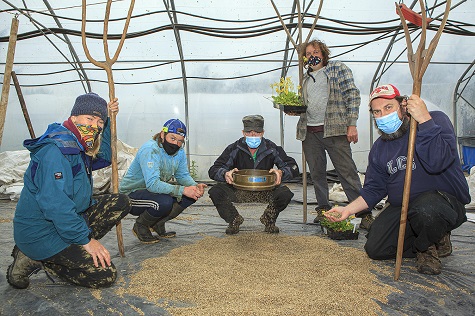
Some of the Design By Nature team from left: Monica Fleming, Martin Rice, Niall Wallace, Sandro Cafolla, Joe Farrell. Photo Alan Mahon
So how does a name like Sandro Cafolla fit in with being involved with promoting Irish native wild flora? Sandro explained to me that his father was Italian and his mother was from Scotland, but her mother was also Italian. Despite this Italian/Scottish lineage, Sandro grew up in Ireland and from an early age got involved with nature and ecology. He remembers having a serious discussion, as an eight year old, with a man in the department of agriculture about organic farming.
Sandro’s business caters for two markets, the amateur gardener and the professional horticulturalist. The customers that Design By Nature has sold seed to, and worked with, is jaw dropping. You only have to visit the website to see who the clients have been each year. 2019 and 2020 were two of the busiest years for the business, despite Covid-19. Customers include small private gardens to large-scale operations such as golf courses, public parks and local authorities. He even helped with the selection and supply of plants for the Irish Hunger Memorial renovation in New York. He is currently involved in an ongoing wild flower project with Ireland’s First Lady, Sabina Higgins, at the presidential grounds of Áras an Uachtaráin in the Phoenix Park, which is not only about creating a native wild flower area there but introducing native apple trees as well.
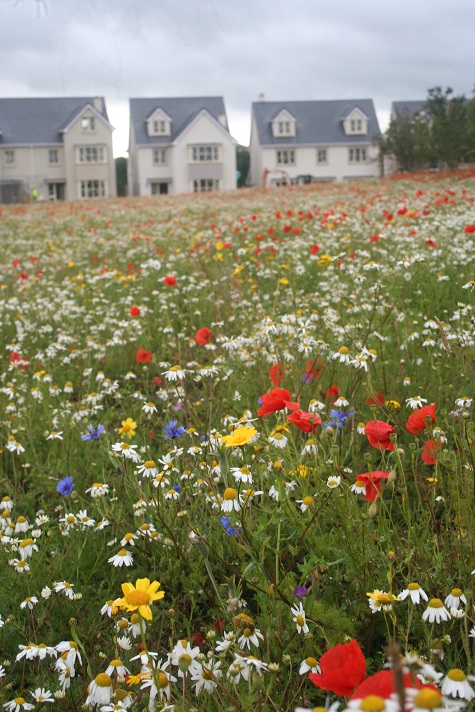
Wild flowers at Pipers Hill, Kildare for Ballymore homes. Photo courtesy Sandro Cafolla
Many of you would be familiar with the ongoing nationwide campaign ‘The Keelings Great Rewilding Initiative’ which offers free wild flower seeds to those who purchase Keelings fruit punnets. It is Sandro who provides the seed which he expertly mixes and packs for this popular campaign, which is trying to help reverse the decline in pollinating insect populations.
Sandro is proud to have been involved with a project by Dun Laoghaire/Rathdown County Council in Cabinteely Park. It was the creation of a wild flower meadow, which started in 2007 and has matured into a wonderful display of flora where schoolchildren often visit on field trips.
Even though the sieving, drying and packing of the seeds takes place at his home, most of the wildflowers are grown and harvested almost 50km away on a 10 acre site on Robert Prout’s farm in Urlingford, Co. Tipperary. Some of the crop is hand picked first then it is combine harvested using a specially adapted combine harvester.
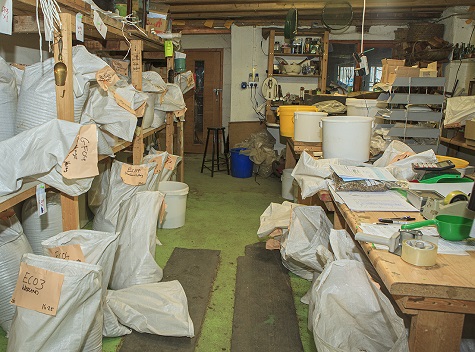
The weighing and packing room. Photo Alan Mahon
Every year, on the Urlingford farm, Sandro organises an Open Day for the general public. However this did not happen in 2020, due to the Covid-19 lockdown. The Open day is also open to the trade such as landscapers, groundsmen and greenkeepers who want to learn more about creating wildflower meadows. It is always a popular day out and Sandro hopes to hold an event sometime during this June or July, though crowd numbers attending will be limited.
Sandro loves seeing children enjoy wild flowers and would love to see them get involved with nature even more. “There is a lack of education in schools when it comes to nature. A lot of children suffer from Nature-Deficit Disorder, which can be easily solved by introducing them to wild flower meadows where they can see the beauty of the flowers but also get a chance to see insects up close” said Sandro.
Sandro’s business ethic is most unusual. He pays himself the same wage as his workers. He has done this for over thirty years. Any profit from the business goes back into subsidising his business, which employs six permanent staff. Profits from the business also help with protecting biodiversity and saving species. Sandro is very passionate about restoring natural habitats and is a supporter of the UN Decade on Ecosystem Restoration 2021 -2030 campaign.

The seed store room is naturally kept at a constant 4°C all year round. Photo Alan Mahon
Coming from a greenkeeping background I am aware that many golf clubs have and are interested in converting their non playing rough areas into wild flower meadows. While this appears to be a good idea, it is not as simple as it looks. The first question that needs to be asked is what kind of meadow is required? Sandro is a firm believer of surveying the site before making a commitment to large scale investment “One size does not fit all”, says Sandro. “Every situation is different. You have to see what ecosystem exists, what soil you have. Is it in a sunny or shady area? I would encourage those who are interested in creating a large wild flower meadow to try a small area first to see how it works out”. Sandro would like to see rough areas on golf courses being defined as ecosystems.
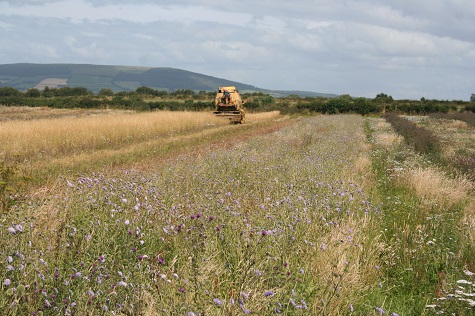
Combine harvesting the seed. Photo courtesy Sandro Cafolla
Sandro makes another good point about golf courses when it comes to selecting a wild flower seed mix. He wouldn’t include species such as dandelions, daisies or plantains as they could encroach onto the fairways, tees and greens. These plants are treated as weeds on golf courses, this would be a good example of when a wild flower becomes a weed. Sandro would rather visit the course himself and survey the area before recommending a mix. Some of the factors that would influence his decision would be if it is a links course, a parkland course or a heathland course.
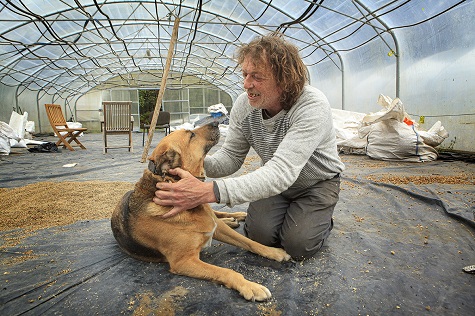
Sandro with his companion dog Dayna. Photo Alan Mahon
Preparing the ground for a wild flower meadow is just as important as selecting the right mix. “To get rid of weeds, you need to deep plough so that you turn the topsoil upside down and bury most of the weeds. By bringing their roots to the surface, you are weakening them. You might have to do this three or four times before you start sowing wildflowers,” says Sandro. He says that you must be patient when undertaking a wildflower meadow project. “Selling Irish wildflower seeds to people is all about managing their expectations. Some people see very colourful pictures of wildflower meadows with cornflowers, poppies and marigolds but this won’t always be your experience when you grow them yourself . . . Meadows are not glossy, showy things. It can take five to eight years for some wildflowers to germinate from seed and come into flower,” says Sandro, whose Design by Nature seeds are guaranteed for three years.
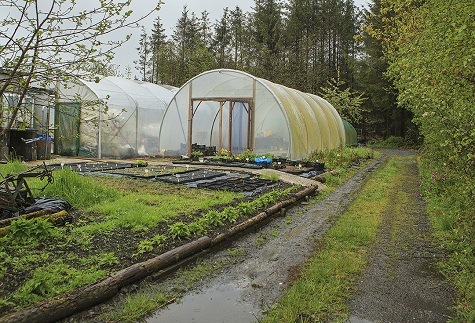
Some of the rare plants are grown at the Design By Nature nursery in Laois. Photo Alan Mahon
Flowery misinformation
One of the things that upsets and annoys Sandro, is false information on seed packets. Some seed companies may include non native species in their mix and claim that it is a native mix. “I don’t mind these non native seeds in the mix as long as the packet says it and that they are sold as general wildflower seed. When you see packets labelled as native flora, which contain seeds that have been introduced from other countries, that really annoys me”, said Sandro. “If a mix contains larkspur, calendula, blue lupine, Californian poppy or many others such as flax, its not a native mix, even if it says wildflower. They are cultivated forms of wildflowers and not natives”.
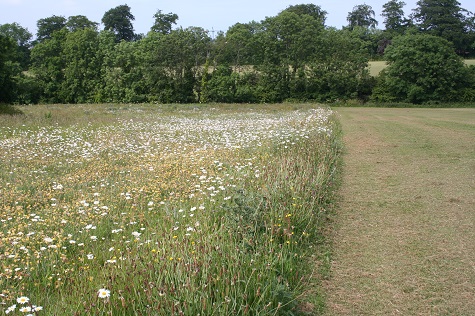
The wildflower meadow at Cabinteely Park, Dublin. Photo courtesy Sandro Cafolla
Another topic that is a bone of contention to Sandro is unsuitable and costly advice given on the subject of growing wildflowers. “You sometimes get information that wildflower seed can be sown directly into grass,” said Sandro. “Only a few flowers can be sown this way. Beginners should never try to plant seed into grass without killing off the grass first. Use plants instead to fill up a lawn with flowers”.
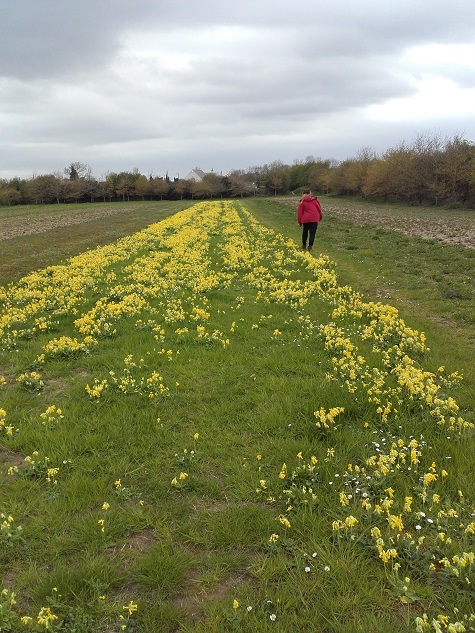
A plot of cowslips. Photo courtesy Sandro Cafolla
According to Sandro, another common flowery misnomer is that wild flowers do better in low fertile soils. “This is not true. If the soil is rich in fertility then you will just have to cut and clear the grass more often and sow a suitable mixture, which we produce. Wetlands, pasture and tall meadows can be rich in fertility and have more wildflowers than most other meadows”.
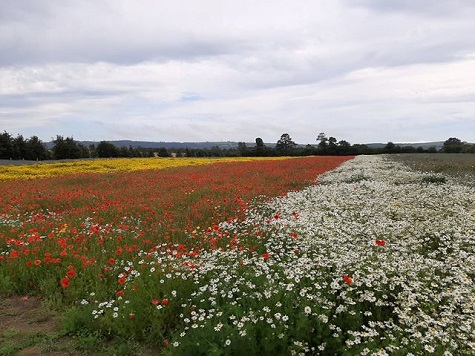
The nursery beds at Urlingford. Photo courtesy Sandro Cafolla
If your golf facility, park or sportsground is thinking of allocating an area for wildflowers you should give Sandro a call. His knowledge is immense and he will put you on the right path. The Design By Nature website is here. It would be worth paying a visit.